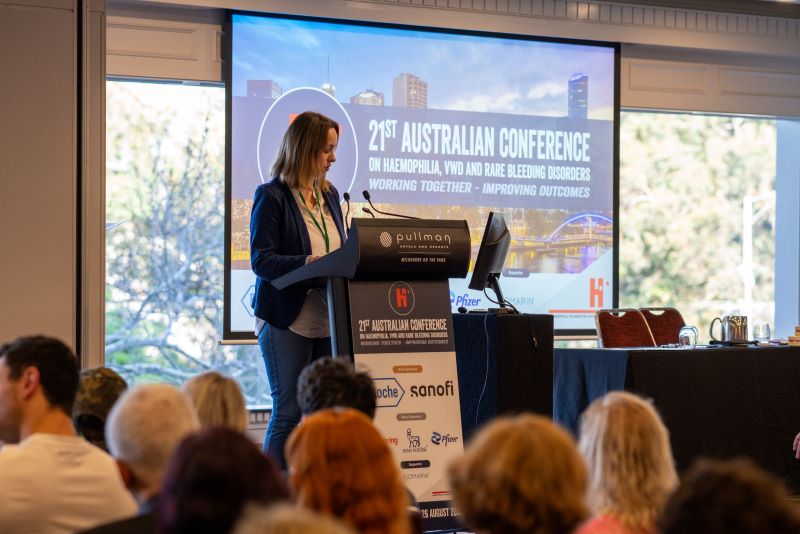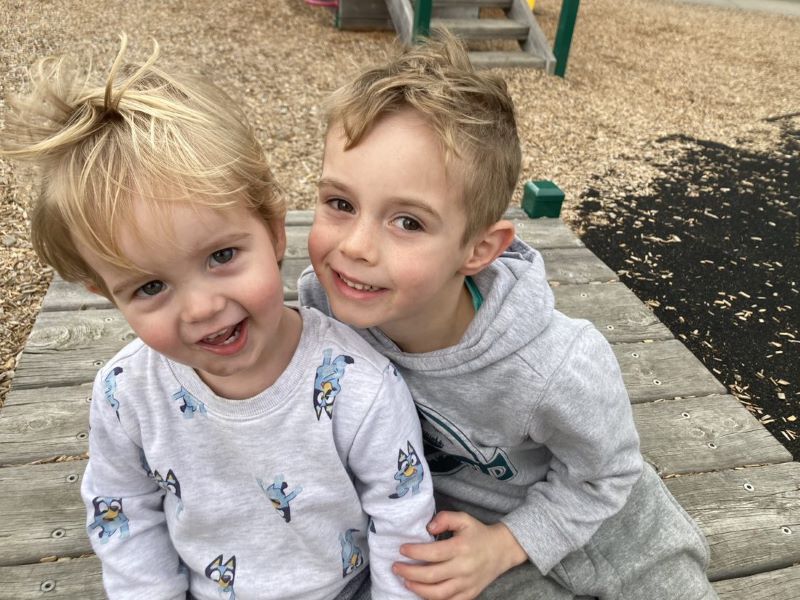Reflections from a parent
Claire shared her personal story as a parent of young boys with haemophilia at the 21st Australian Conference on haemophilia, VWD and rare bleeding disorders. This is a transcript of her presentation.

DIAGNOSIS
‘His blood is not clotting.’
I can vividly remember these words when I heard them for the first time.
Good morning, my name is Claire and I am the mother of 2 young boys who have severe haemophilia A.
There is no family history. It was the shock of our life for my husband Ben and I when we found out that our firstborn Louis was diagnosed at 6 months old.
It was a Saturday night. We took Louis to the ED at our local hospital as he had developed some pretty bad bruises at the back of his knees; he just started sitting in his high chair, banging his feet against it and had developed some pretty nasty black bruises.
‘What do you mean his blood is not clotting?’ was my first question to the doctor at the Emergency Department.
As a first-time mum, there is a constant worry.
But as a first-time mum of a child who has a severe medical condition, that worry is exacerbated: we just entered a whole new world, where all of a sudden nothing much mattered but the health of our little boy.
I quickly expanded my everyday vocabulary with words I never heard before.
I am always welcoming new words being a non-native speaker of the English language, but I guess I didn’t have these ones in mind:
Clotting
Bleeds
Factor VIII
Long lasting
Ports
The list goes on…

Fast forward 6 months later: Louis had to have a port put in place to allow us parents to treat him intravenously with long lasting factor VIII.
As parents, we had to learn to infuse Louis.
While we had our fair share of scares with the port and numerous hospitalisations, the port did allow us to travel overseas and live a life as ‘normally’ as possible.
NEW THERAPIES
Another 3 years later, Louis had the opportunity to start on an non-factor treatment product.
What a game changer it has been!
From intravenous port access 3 times a week to a monthly subcutaneous jab, it has revolutionised Louis’s and our life.
We noticed a significant reduction of bleeds, improving Louis’s physical and mental health therefore impacting our family’s quality of life.
It has brought different challenges though for our family, refusal to do treatment at times which has been bringing some angst for everyone.
And then, 2020 happened, confinement and perhaps some would say a baby boom in 2021…
Téo, who is now 2, was born. He was diagnosed at birth and it was not a huge surprise or shock for us.
His journey has been a very different one, if we had to compare it to his older brother – as he started treatment much earlier.
We are part of a clinical trial and for us, it has meant no bleeds in two years.
There haven’t been any hospitalisations, any port, any intravenous access…just few blood samples and his monthly needle.
Without minimising Téo’s journey, it has been a much smoother sail for Téo and for all of us as a family.
THE FUTURE

We are very aware and very grateful that in the past 6 years, treatment for haemophilia has drastically changed and a utopic future would be a cure for haemophilia…
Gene therapy is allowing us to grab a glimpse of what a world without haemophilia could be.
One of my first hope would be a treatment that would not involve a needle.
I haven’t met anyone who loves needles, I mean, do you? The reality of a needle on a young child is not a pretty one, and can be pretty traumatic for all parties involved.
Another hope, as my boys are growing and one day will be teenagers, is to avoid bleeds at any cost – and the current treatment is providing us with that hope.
We know that with past treatments, bleeds still happened regularly for some families.
We know what it does to them to miss out on school, birthdays, camps, sleepovers, everyday life activities because they have had a bleed.
We know as parents the negative impact it has on their physical and mental health.
We want to look after them as much as possible and we don’t want them to experience early arthritis because they have had numerous bleeds during their teenager years.
We want them to avoid pain.
In 15 years, my boys will be young adults and will perhaps have the choice and opportunity to have gene therapy. I want them to make that decision the most informed possible.
Gene therapy might be the future for haemophiliacs, but what about the next generation? What about their daughters?
Gene therapy does not cure the carriers. Could it one day though?
The real hope for the future is an eradication of haemophilia for the next generations –
I want Louis and Téo to live their best life possible.
I want them to become confident and articulate advocates for themselves.
I want them to travel and see the world.
I don’t want haemophilia to stop them from doing anything they want to do.
When we first met our haematologist 6 years ago, we were told that everything will be OK and from that day I still believe that everything is going to be OK.
So right now, the future for us is looking pretty optimistic.
Photos supplied by Claire and reproduced with permission.
Stock image: Pixabay for Pexels.com
This personal story was originally published in National Haemophilia No 224 December 2023.


